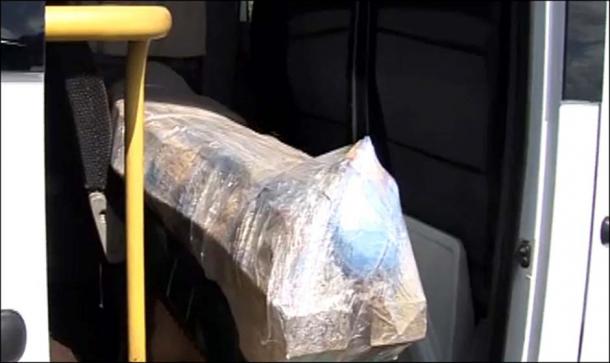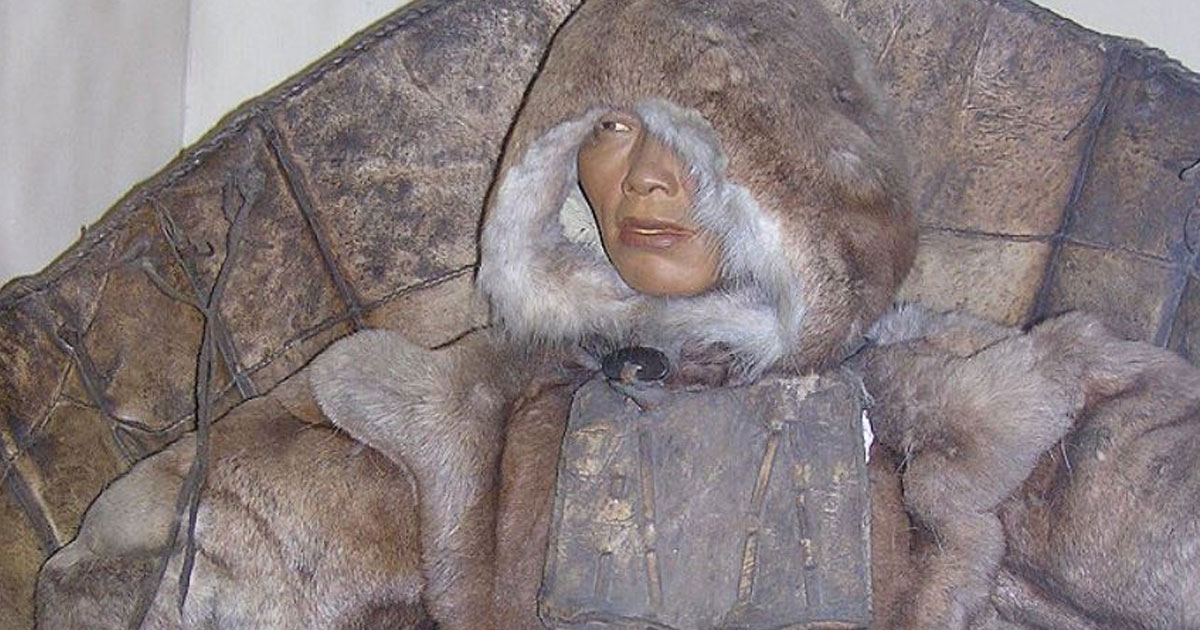Meet the Mummified Polar Beauty, First Female to be Recovered from Siberian Necropolis
By Anna Liesowska, Siberian Times
Unearthed on the edge of the Arctic, she is the only woman so far found in an otherwise all-male necropolis, buried in a cocoon of copper and fur.
She has long eyelashes, a full head of hair - and impressive teeth.
This haunting 12th century woman is a member of an unknown hunting and fishing civilization that held sway in the far north of Siberia - with surprising links to Persia.
Accidentally mummified and probably aged around 35, her delicate features are visible, the green tinge on her face being the traces of the pieces of a copper kettle that helped preserve her in her permafrost grave.
She has long eyelashes, a full head of hair - and impressive teeth.
Bronze temple rings were found close to her skull, wrapped inside animal skin - possibly reindeer - and birch bark that cocooned her.

Siberian Sakha woman in Yakutsk posing in folk costume. (Aleksandr Ivanov/CC BY-SA 2.0)
Like other human remains, the medieval mummy's feet were turned towards nearby Gorny Poluy River, a fact seen as having religious significance.
She was around 155 centimeters tall - 5ft 1 inch.
- Charred Turnip Dinner From 400 Years Ago Throws New Light on Conquest of Siberia
- Found: Grave of Siberian Noblewoman up to 4,500-Years-Old With Links to Native Americans
- 1,200-Year-Old Mummies of Adult and Baby Found Cocooned in Copper, Fur and Bark in Siberian Permafrost


A cocoon with a mummy of an adult was covered with copper plates head to toe. Picture: Alexander Gusev
A baby - almost certainly a girl and too young to have teeth - also unearthed during this summer's dig at Zeleny Yar archaeological site near Salekhard is not believed to be related to the woman, the rest of whose body is not well preserved.
Archaeologist Alexander Gusev, from Russia's Arctic Research Centre, confirmed that the copper-clad mummy was the first find of an adult woman in this ancient burial site.
'There are some badly preserved bones, which do not allow us to determine the gender, but we clearly see from the face that she was a woman,' he said.
'This radically changes our concept about this graveyard.
'Previously we thought that there were only adult men and children, but now we have a woman.
'It's amazing.'
The people to which this woman belonged survived by hunting and fishing on the edge of the Arctic Circle - but among three dozen adult graves previously investigated, all contained male remains, some with their skulls smashed, possibly suggesting this woman was socially important.
There were also graves of children of both genders.
A raft of tests - including DNA - will be carried out by the joint team of Russian and South Korean scientists investigating these archaeological remains.
- Mystery mummies uncovered in Russia have connections to Persia
- 25,000-Year-Old Buildings Found in Russia
- Dmitri of Uglich and the Three False Dmitris: One of the Most Bizarre Episodes in Russian History
Dr Sergey Slepchenko, researcher at the Institute of the Problems of Northern Development SB RAS, Tyumen, said the head preserved well because it was 'wrapped' in pieces of copper kettle.
'The woman and the baby are from different graves, so we cannot say they are related,' he said. 'Definitely not a mother and child.'
Analysis is likely to take a year - and will depend on government funding for analysis seen by the academics as crucial to understanding the human presence in the Arctic.
He hopes to reconstruct the face of the woman.
Dr Slepchenko said: 'During the natural conservation of the mummy in the soil, the rotting process was completed.
'The remaining soft tissues were soaked with copper solution from those ritual plates with which the bodies were covered.'
Brain samples have been taken from the woman for paleo-DNA analysis


'Arctic mummies, similar to those found in the Zeleny Yar, are very rare.' Pictures: Institute of the problems of Northern Development SB RAS
Prof Dong-Hoon Shin, from Seoul National University, said: 'In the world there are two types of mummies - artificial and natural.
'Excellent examples of mummies of artificial origin are Egyptian. The natural mummification of bodies of the buried is usually observed when certain conditions of the environment - permafrost, the presence of copper objects in the burial - and climate. They are found in deserts and in the north. Arctic mummies, similar to those found in the Zeleniy Yar, are very rare. That is why they are unique.'
He said: 'Due to the high level of preservation the mummies internal organs are intact, too, which is incredibly interesting for our research.'


The mummy on way from the burial site to laboratory. Pictures: Alexander Gusev
Previous finds at the Zeleniy Yar burial site near Salekhard have included bronze bowls originating in ancient Persia, around 6,000 kilometers to the south-west.
One earlier find was a 'red-haired man' buried with a bronze buckle depicting a brown bear.
Top image: Reconstruction of a Siberian woman wearing laminar armor of hardened leather enforced by wood and bones worn by the Chukchi, Aleut, and Chugach people. (Andrew Butko/CC BY SA 3.0)
The article, originally titled ‘Meet the mummified Polar beauty, her long eyelashes and hair still intact after 900 years’ originally appeared on The Siberian Times and has been republished with permission.


















Comments
What a fantastic find and so much to learn from it. It will be extremely interesting to see if they can come up with a reconstruction of her face.
I think this story is somehow linked to this one:
http://www.ancient-origins.net/news-history-archaeology/skull-1000-year-...
I'd love to see a reconstruction of what we think she may have looked like.